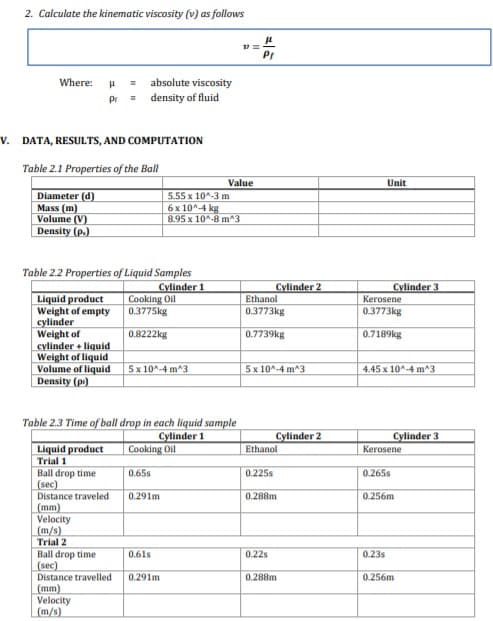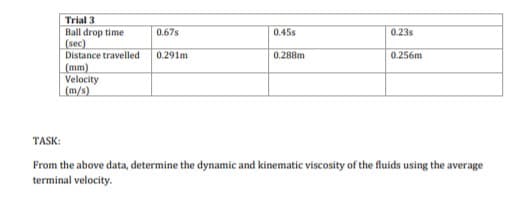2. Calculate the kinematic viscosity (v) as follows Where: - absolute viscosity P. density of fluid . DATA, RESULTS, AND COMPUTATION Table 2.1 Properties of the Ball Value Unit Diameter (d) Mass (m) Volume (V) Density (p.) 5.55 x 10-3 m 6x 104 kg 8.95 x 10-8 m*3 Table 22 Properties of Liquid Samples Cylinder 1 Cooking Ol Cylinder 3 Kerosene 0.3773kg Cylinder 2 Liquid product Ethanol Weight of empty 0.3775kg cylinder Weight of cylinder + liquid Weight of liquid Volume of liquid 5x10^-4 m^3 Density (p) 0.3773kg 0.8222kg 0.7739kg 0.7189kg 5x 10-4 m^3 4.45 x 10^-4 m^3 Table 23 Time of ball drop in each liquid sample Cylinder 1 Cooking Oul Cylinder 2 Cylinder 3 Liquid product Trial 1 Ethanol Kerosene 0.65s 0.225s 0.265s Ball drop time (sec) Distance traveled (mm) Velocity (m/s) Trial 2 0.291m 0.288m 0.256m 0.23s Ball drop time (sec) Distance travelled (mm) Velocity (m/s) 0.61s 0.22s 0.291m 0.288m 0.256m
2. Calculate the kinematic viscosity (v) as follows Where: - absolute viscosity P. density of fluid . DATA, RESULTS, AND COMPUTATION Table 2.1 Properties of the Ball Value Unit Diameter (d) Mass (m) Volume (V) Density (p.) 5.55 x 10-3 m 6x 104 kg 8.95 x 10-8 m*3 Table 22 Properties of Liquid Samples Cylinder 1 Cooking Ol Cylinder 3 Kerosene 0.3773kg Cylinder 2 Liquid product Ethanol Weight of empty 0.3775kg cylinder Weight of cylinder + liquid Weight of liquid Volume of liquid 5x10^-4 m^3 Density (p) 0.3773kg 0.8222kg 0.7739kg 0.7189kg 5x 10-4 m^3 4.45 x 10^-4 m^3 Table 23 Time of ball drop in each liquid sample Cylinder 1 Cooking Oul Cylinder 2 Cylinder 3 Liquid product Trial 1 Ethanol Kerosene 0.65s 0.225s 0.265s Ball drop time (sec) Distance traveled (mm) Velocity (m/s) Trial 2 0.291m 0.288m 0.256m 0.23s Ball drop time (sec) Distance travelled (mm) Velocity (m/s) 0.61s 0.22s 0.291m 0.288m 0.256m
Engineering Fundamentals: An Introduction to Engineering (MindTap Course List)
5th Edition
ISBN:9781305084766
Author:Saeed Moaveni
Publisher:Saeed Moaveni
Chapter4: Engineering Communication
Section: Chapter Questions
Problem 18P
Related questions
Question

Transcribed Image Text:2. Calculate the kinematic viscosity (v) as follows
Where: H = absolute viscosity
= density of fluid
Pr
v. DATA, RESULTS, AND COMPUTATION
Table 2.1 Properties of the Ball
Value
Unit
Diameter (d)
Mass (m)
Volume (V)
Density (p.)
5.55 x 10^-3 m
6х 10^-4 kg
8.95 x 10^-8 m^3
Table 2.2 Properties of Liquid Samples
Cylinder 1
Cooking Ol
0.3775kg
Cylinder 2
Cylinder 3
Liquid product
Weight of empty
cylinder
Weight of
cylinder + liquid
Weight of liquid
Volume of liquid
Density (po)
Kerosene
0.3773kg
Ethanol
0.3773kg
0.8222kg
0.7739kg
0.7189kg
5x 10^-4 m^3
5x 10^-4 m^3
4.45 x 10^-4 m^3
Table 2.3 Time of ball drop in each liquid sample
Cylinder 1
Cooking Oil
Cylinder 3
Kerosene
Cylinder 2
Liquid product
Trial 1
Ethanol
Ball drop time
(sec)
Distance traveled
(mm)
Velocity
(m/s)
0.65s
0.225s
0.265s
0.291m
0.288m
0.256m
Trial 2
Ball drop time
(sec)
Distance travelled
(mm)
Velocity
(m/s)
0.61s
0.22s
0.23s
0.291m
0.288m
0.256m

Transcribed Image Text:Trial 3
Ball drop time
(sec)
Distance travelled
(mm)
Velocity
(m/s)
0.67s
0.45s
0.23s
0.291m
0.288m
0.256m
TASK:
From the above data, determine the dynamic and kinematic viscosity of the fluids using the average
terminal velocity.
Expert Solution
This question has been solved!
Explore an expertly crafted, step-by-step solution for a thorough understanding of key concepts.
Step by step
Solved in 4 steps

Knowledge Booster
Learn more about
Need a deep-dive on the concept behind this application? Look no further. Learn more about this topic, civil-engineering and related others by exploring similar questions and additional content below.Recommended textbooks for you

Engineering Fundamentals: An Introduction to Engi…
Civil Engineering
ISBN:
9781305084766
Author:
Saeed Moaveni
Publisher:
Cengage Learning

Engineering Fundamentals: An Introduction to Engi…
Civil Engineering
ISBN:
9781305084766
Author:
Saeed Moaveni
Publisher:
Cengage Learning